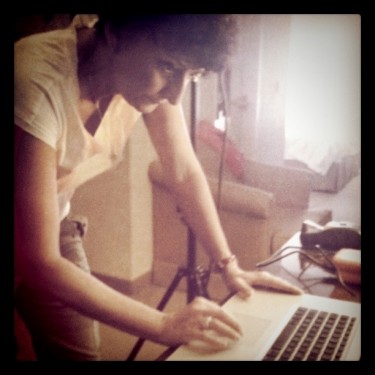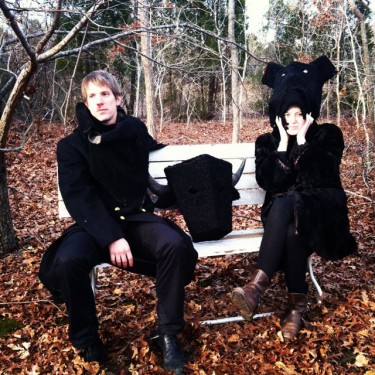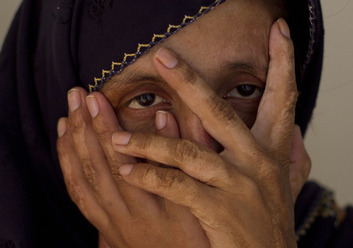 Back to selection
Back to selection
An Interview with D.P. Martina Radwan
I started working with DP Martina Radwan about a year ago on the feature documentary, Mentor (addressing bullying and teen suicide in Mentor, Ohio) I further had the pleasure of working with her on a recent music video for the band Shearwater. It is a gift, as a director, to find a DP who you can quickly fall into a shorthand with, creating your own visual language, and trusting in the collaborative process. Radwan and I found this with each other.
Her narrative work includes Flannel Pajamas, by Jeff Lipsky; Singapore Dreaming, one of the first Singaporean feature productions and the winner of several international awards; Rain, the first indigenous film of the Bahamas, produced and directed by Maria Govan; The Killing Floor, a thriller produced by Doug Liman & Avi Arad and the horror film Train, a Millennium Films production, both directed by Gideon Raff.
Her most recently-released documentaries include William Kunstler: Disturbing the Universe by Emily & Sarah Kunstler, and Beautiful Darling, by James Rasin. I sat down with her recently to discuss her beginnings as a cinematographer, women as directors and cinematographers, and Saving Face, the Oscar-nominated short doc she shot this past year.
 FILMMAKER: How did you first get interested in cinematography?
FILMMAKER: How did you first get interested in cinematography?
RADWAN: I was always interested in images because to me the visual language leaves more room for interpretation then the spoken word. You can allow the audience to add their own emotions and impressions to the story. Images are a universal language, as we know from silent movies. Growing up in Germany, I watched many American movies, and if the visual language was strong enough, I could understand the film, without understanding the spoken language. I was a school drop out which prevented me form going to college, so I worked my way up from PA to Assistant Camera, and I started shooting after I moved to the US.
FILMMAKER: What was your first production assistant job?
RADWAN: It was an American German co-production starring Martin Sheen and Sean Penn — I think Sean Penn’s father was directing it. I am not sure if the film was widely seen. It was called Judgment in Berlin.
My biggest job in Germany was on Wim Wenders’ Far Away So Close. I was 1st AC for the 2nd camera unit and ended up becoming the Steadicam AC. One day Henri Alekan and his longtime gaffer visited us – that was one of the most memorable events in my career. But I never managed to move up in Germany. Germans are not very supportive of change — at least that’s how I saw it then. If you are known as AC no one wants to see you move up.
FILMMAKER: What was your first cinematography job?
RADWAN: I started out the classic way. After I moved to New York, I would go to colleges with film programs and read the bulletin boards for ads — students looking for shooter. I eventually I got my first film, about a girl who was crazy for candy. Everything in the film was pink!
FILMMAKER: I would like to see that.
RADWAN: I don’t think I have it anymore. I think I threw out all of the old films that I had only on VHS. Can you believe that?
FILMMAKER: So how do you move from AC to shooter?
RADWAN: When I moved to New York, I did it the American way – I just said I AM a shooter, and thankfully people believed me. Over time I had shot enough projects, so I could put together a reel. I shot mainly narrative shorts – some of them were good, some of them weren’t, but I always tried to push the envelope, I always tried to bring in a new idea that would stand out.
FILMMAKER: Is there a difference between how you approach shooting a documentary to how you shoot a narrative film?
RADWAN: Honestly, I try to mix them. It always depends on the story, but I try to approach a feature a little bit like a documentary and vice versa. I try to bring narrative elements into documentaries. I try to bring in a certain kind of visual language that is specific to the film and keep it consistent. For example what we did in Mentor – the idea of absence. You create the imagery with a certain topic in mind that conveys the idea of the movie. That’s a decision that you make. People often think that capturing the action is the main element in documentaries – which is true, but you capture it from a certain angle. If you look at Salesman, it almost looks like a narrative because of the decisions the filmmakers made. They chose to shoot from a certain angle in a certain way, with a certain shot length, to convey the story that they wanted to tell. When I shoot a narrative feature, I prepare well. I talk with the director about ideas, we develop a shot list and obviously we go scouting. Once you know what you want, you’ll be able to throw the plans out the window, depending on what everyone else brings in. You want to serve the actor because the actor is serving the story, but you discover only on set what the actor needs. Or if the available light hits a certain angle that conveys a mood that fits the story, then you build the shot list around that light and you allow it to be what it is. You have to be ready to improvise. I’m a big fan of lighting areas rather than lighting people, so you can allow the people to own the space. You don’t have to tell them to hit a mark or where to be. I love to start with a concrete plan, but then be loose on the set and be able to react to what happens.
 FILMMAKER: We just finished a music video together – is there a whole different approach when thinking about music videos?
FILMMAKER: We just finished a music video together – is there a whole different approach when thinking about music videos?
RADWAN: You can be more expressive with a music video because you have to convey something in a very short amount of time. You can exaggerate, which is such a no-no in narrative and documentary, where you don’t want to exaggerate because you don’t want to force the audience to feel a certain way. But in a music video you can do that — you can be creative with fewer boundaries. Look at Shearwater – you put people in a funky costume and you sent them through the woods and you shoot it a certain way – there’s a story right away. There is no back story or explanation – you can go visually full-out, using strong visual elements. You set your rules and you stick with them and so it becomes cohesive. You only have three-and-a-half minutes, so every shot has to count. There are no cutaways in a music videos.
FILMMAKER: Or there are only cutaways. How do you approach working with different directors?
RADWAN: I love directors, who have an idea and know what she or he wants. That is all I need, because then I know what to do. When I was younger I was so focused on the great ideas that I have. Of course, I want to include my own ideas, but they just come naturally when you have a great collaboration.
FILMMAKER: Is there anything you have seen lately, or not lately, where the cinematography has especially impressed you?
RADWAN: I guess my favorite film of the last couple years has been I am Love (DP: Yorick Le Saux). I was blown away when I saw it for the first time. The way he used space and light so beautifully. The first half of the film takes place in a huge palazzo, presented in very graphic wide shots, yet we feel how claustrophobic the situation is for the main character. When she finally escapes, the camera follows her in tight shots, yet we feel the relief, the freedom. The light is so strong, you feel the heat of the day, the energy that the sun.
I really liked Bombay Beach, which won Best Documentary at Tribeca in 2011. That said, I have a problem lately because so many films look just like a 5D or RED. It often just looks the same. I was just voting for the Spirit Awards, and discovered The Dynamiter, shot by Jeffrey Waldron. It was refreshingly different, low contrast, pastel colors, with an overall limited color palette and beautiful framing. No bells and whistles, just beautiful, meaningful photography.
FILMMAKER: Do you think that the new cameras have produced a certain type of laziness?
RADWAN: I wouldn’t call it laziness. Sometimes it just seems that the focus has shifted. Everyone is so excited about the new cameras and the tools, and so am I, but I miss the dialogue about what is happening in front of the lens. I really have the feeling that I belong to an older generation – I don’t care about the camera as much, until I have a context in which I can use it. I’m just looking at these rigs where you have a tiny camera mounted on a huge rig, and you are battling focus and movement, you are restricted in your spontaneity, something I have gotten very used to of having, with light weight 35mm cameras and with small video cameras. That said, these cameras have their place, and when used accordingly, they look gorgeous and offer an entire new palette. As much as I sound like I am complaining. I own a 7D and I love it. It reminds me of the time when everyone talked about how little their film cost to make – never taking into consideration that entire crews had worked for free, and that service deserves a number attached to it – when budget became the primary discussion point, rather then content and craft.
FILMMAKER: You’re directing your own film now, can you explain what the film is, and why you decided to hire a shooter rather than shoot it yourself ?
RADWAN: The film is currently called The Roar of A Lion Cub, referring to the main character. It is about three homeless teenagers, in Mongolia, who are trying to overcome their circumstances. The film starts after they’ve a home and in most cases an education, and we follow them in their struggle to become independent adults. I am asking the question, “Can one overcome the consequences of a terrible upbringing?” Because I am the reason for the kids being off the streets, I had to be in the film, which led to my needing another DP, with whom I could share the shooting. I am in the strange situation of having to make breakfast, set up doctor’s appointments or job interviews, while I am directing and shooting.
FILMMAKER: How did you choose someone, and do you find it difficult not to micro-manage?
RADWAN: Well, it’s tough. It’s very tough. You have to choose someone you trust enough so you can let go. Micro-managing can be very destructive, which I have experienced numerous times. So I believe, because I chose someone whose visual sense I trust, as well as her ability to capture the story, that I will be able to surrender.
FILMMAKER: Who is your shooter?
RADWAN: Julia Dengel. She is a true verite documentarian, and she’s very much interested in human behavior. I wanted somebody to be able to see the fine nuances of human interaction and shoot in an observing style. The children and I have no common language, so everything is in the body language and facial expression.
FILMMAKER: How did you come upon this story?
RADWAN: It is based on my experience in Mongolia. I was hired for a shoot in 2008, to film a segment about homeless kids. I met one boy, Baaskaa, who had lived on the street half his life and I decided to help him. Naturally, I turned my camera on him, and the other kids, who I subsequently took on. I’ve been shooting on and off since 2008.
FILMMAKER: When is your next trip there?
RADWAN: At the end of February. It will be my tenth trip.
FILMMAKER: Does it make you feel like you want to do more directing?
RADWAN: To be honest all I want to do is tell a story. Ideally I want to do it with a camera.
FILMMAKER: In filmmaking, I think the roles of directing and cinematographer are the two roles least populated by women. Do you have anything to say about that?
RADWAN: I find it strange that with all the progress we are making, the role of women – and by that I mean the under representation of adult, decision-making women – has not changed. I believe the resentment to women in leading positions is still based on the belief that women aren’t able to lead a large group of men. I love working with and being in charge of large groups of people, because it gives me the opportunity to listen to new ideas. That doesn’t mean that I won’t make a decision at the end of a conversation, or that I won’t be able to make a quick decision, trusting my knowledge.
 FILMMAKER: A film you shot was just nominated for an Oscar – can you tell me about that?
FILMMAKER: A film you shot was just nominated for an Oscar – can you tell me about that?
RADWAN: The film is called Saving Face, directed by Daniel Junge and Sharmeen Obaid and nominated in the Short Documentary category. It’s the story of several women who became acid victims and their resilience and courage to fight in order to change the laws in Pakistan, to make acid throwing a crime. It is also the story of a London-based Pakistani plastic surgeon, who travels twice a year to Pakistan and operates on the women to reconstruct their faces, for free, because he wants to give back.
FILMMAKER: You mentioned that one of the challenges on that film was how to shoot someone whose face is largely missing.
RADWAN: That was tough. Most of these women have done nothing wrong, but were punished in the most cruel way, often by their spouses or families. We shot in a safe house for acid victims, and were surrounded by disfigured women, who all had such grace and courage, it was amazing. But how do you shoot someone, who has almost no face, or a largely disfigured face, without scaring the audience, or simply creating pity? That was quite a challenge. It’s a lot about light, angle, draping the face, without hiding it. I think we did a great job of allowing the women to be who they are.
(Top photo of Martina Radwan by Alix Lambert.)
